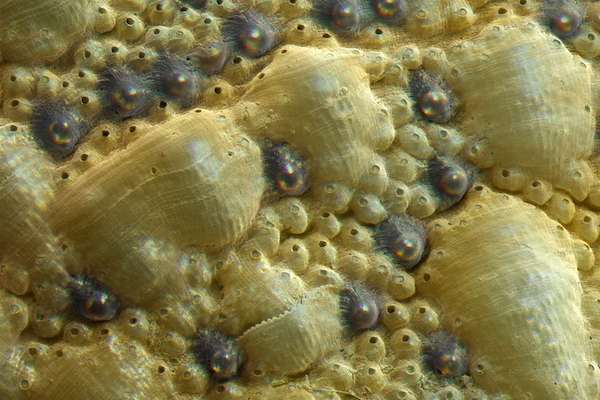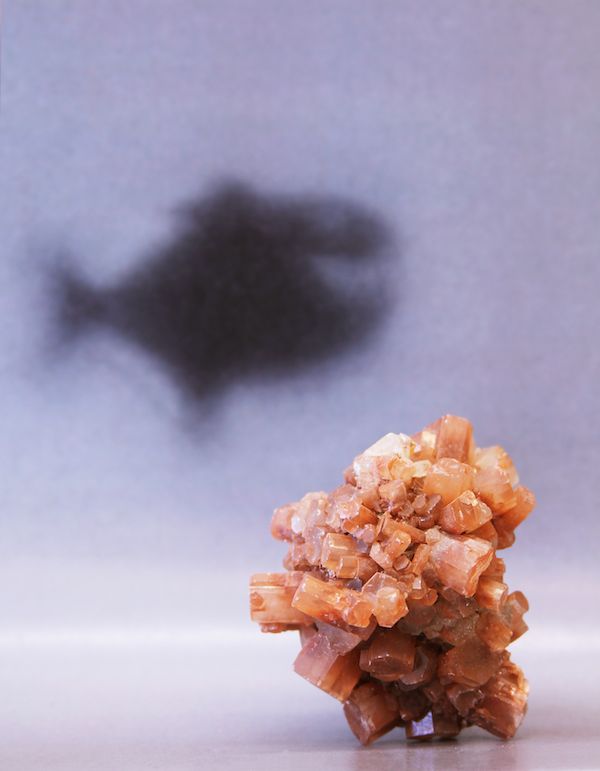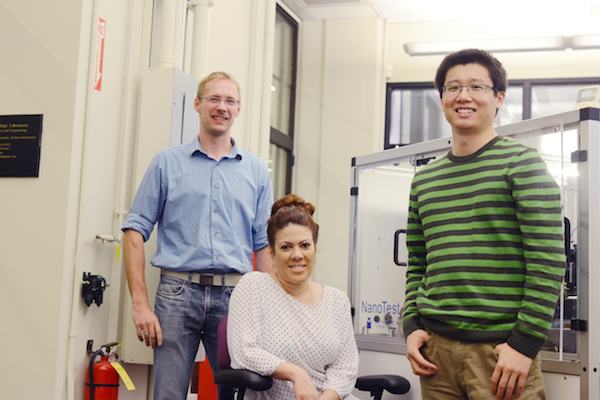
Few structures simultaneously achieve the normally opposing functions of protection and visibility. But a few have—including bulletproof glass, sintered spinel, and the popemobile.
Here’s one more to add to the list: chiton shells.
These marine mollusks, descendants of ancient trilobites, have strong shells with overlapping plates to afford the animal flexibility and protection—like a pill bug.
Ivy league researchers now show that chitons have an even more interesting feature to adapt to their life under the sea—hundreds of tiny eyes integrated in and scattered across their strong aragonite shells.
Chitons are a prey species that live attached to hard surfaces, such as rocks. So eyes allow chitons to detect approaching predators and clamp tightly onto those hard surfaces to hopefully prevent being dislodged and eaten.
Although the chitons’ tiny eyes—each just a tenth of a millimeter in diameter—had been previously identified and were thought to perform a photosensory function, the team’s Science paper is first to report that the eyes can form focused images.
The team includes researchers from Massachusetts Institute of Technology, Harvard University, and the University of South Carolina.
“A lot of people thought the eyes were so small, there was no way this small lens would be capable of forming an image,” MIT researcher Matthew Connors says in an MIT News article.
Unlike other creatures, the chiton’s eyes are spread across their shells rather than being localized to a particular area. And while most creatures’ eyes are made of organic materials, particularly proteins, chiton eyes are chiefly composed of inorganic materials—the same ceramic stuff that makes up the rest of the chitons’ shells, aragonite.
According to the Science paper, “Chitons are the only known group of extant mollusks to have living tissue integrated within the outermost layer of their shells.” And that could mean big things for understanding and designing manmade multifunctional materials.
The researchers studied one particular species of chiton, Acanthopleura granulate, and used a variety of high-resolution microscopy and crystallography techniques to see, once and for all, if chitons could see.
The team’s up-close look showed that the lens, although composed of the same mineral as the chiton’s shell, is structurally different. The lens contains large aragonite crystal grains that are uniformly aligned, whereas the shell contains a more granular and scattered orientation of smaller crystals.
The researchers speculate in the paper that larger grains reduce grain boundaries to minimize light scattering in the lens, making those regions transparent while the rest of the shell is opaque.
Testing individual lenses underwater proved that chitons indeed have the ability to see through these see-through eyes—the lens could resolve a 20-cm object from a distance of about 2 m. In an intact, alive creature, that image projected through the lens would pass underneath the shell into a photoreceptive chamber that allows the chiton to sense its environment.

A large crystal of chiton shell mineral aragonite in the foreground of a focused image of a fish as might be seen through a chiton lens. Credit: Courtesy of the researchers; MIT
Because chitons often live in intertidal zones where they are exposed to intermittent periods of either air or water, the team also used modeling to show that the eyes could focus light to detect images in air and in water.
But visibility comes at a price.
“We also learned that optical performance was developed as a second function to the otherwise protective shell with mutual trade-offs in both functionalities. The material properties that are favored for optical performance are usually not favored for mechanical robustness so that the evolving chiton had to balance out its mechanical vulnerabilities by limiting the size of the eyes and placing them in regions protected by strong protrusions,” co-first author and Harvard postdoctoral fellow Ling Li says in a Wyss Institute press release.
Mechanical tests show that the eyes are indeed less structurally stable than the rest of the shell, perhaps informing why the eyes are tucked in between mounds in the shells. Locating the structurally weaker eyes within these valley may help protect the eyes and maintain overall shell strength.

Close-up image of part of the chiton shell shows the eyes (dark bumps with shiny centers) that cover the shell surface. The small bumps with black centers are sensory organs called aesthetes, and the protective mounds in the shell are visible. Credit: MIT
Although increasing lens size would improve the creatures’ sight, the authors report, it would also decrease mechanical stability of the whole shell to such an extent that damage could no longer be localized—so the chiton shell represents a compromise between these two opposing functions.
“High-resolution structure and property studies of the chiton system provide fascinating discoveries into materials-level tradeoffs imposed by the disparate functional requirements, in this case protection and vision, and are key to extracting design principles for multifunctional bio-inspired armor,” Christine Ortiz—senior author on the paper and the Morris Cohen Professor of Materials Science and Engineering and MIT’s dean for graduate education—says in the MIT article.
[We’ve covered marine-inspired research from the Ortiz lab before, including this story about the photonic structures within the blue stripes on limpet shells and this one about the surprising strength that microstructure affords calcite shells of windowpane oysters.]
Joanna Aizenberg—a senior author on the paper and Amy Smith Berylson Professor of Materials Science at the Harvard John A. Paulson School of Engineering and Applied Sciences—adds in the Wyss release: “To date, artificial materials that have the ability to perform multiple and often structurally opposite functions are not available. We can not yet rationally design them but studying different multifunctional biomaterials present in nature should ultimately allow us to deduct the key principles for this relatively new area of materials science.”
[We’ve also covered research from the Aizenberg lab before, including this story about how tungsten oxide islands can protect steel from fouling.]

From left, assistant professor Mathias Kolle, professor Christine Ortiz, and postdoc Ling Li. Credit: Ling Li; MIT
The new paper also includes and was inspired by previous biological research from Daniel Speiser of the University of South Carolina.
According to the Wyss release, the new findings from chiton shells could help develop multifunctional materials that can sense the environment, including developments that could “enable us to build houses that make use of their environments, to constantly monitor wear-and-tear and look for signs of damage in materials, or even to better deliver some drugs and produce bioengineered organs.”
The paper, published in Science, is “Multifunctionality of chiton biomineralized armor with an integrated visual system”(DOI: 10.1126/science.aad1246).
Interested in more imaging news? Beyond the biological world, researchers at Rice University have developed their own innovation for imaging—their FlatCam is a small, flat, flexible camera can take an image, completely sans a lens.
Interested in more biomaterials news? Researchers at the University of Copenhagen have used X-ray microtomography to unveil why marine creatures called heart urchins are so strong despite their simple composition of calcium carbonate and air. Their work shows that the creatures’ shells “have a structure that nears a theoretical ideal for foam structure strength.”
And researchers at Cornell University have used high-resolution scanning transmission electron microscopy to make important observations that inform the formation of nacre. Their investigation of a thin film of nacre shows that the material contains calcium carbonate nanoparticles that are deposited layer by layer and fuse into light-scattering flat crystals, giving nacre its characteristic iridescence.

